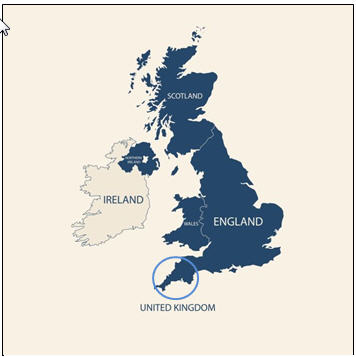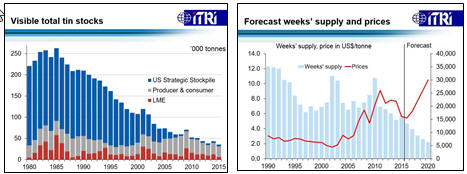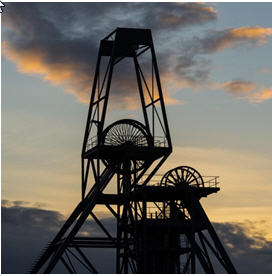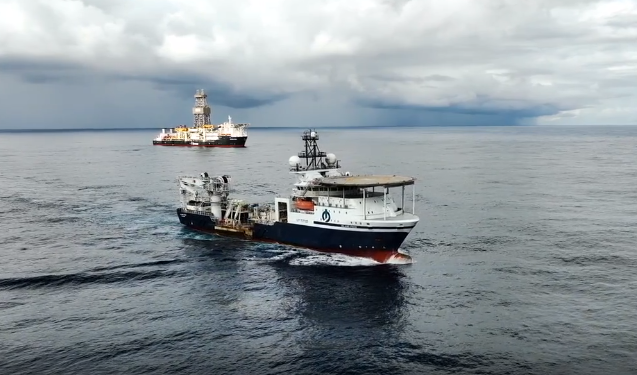Cornwall tin: Revival of the fittest
There are few English dishes more satisfying than a Cornish pasty. A crescent shaped pastry filled with steaming beef and swede, the pasty somehow manages to be simultaneously sweet and savoury, dainty yet robust. Perfected by Cornish wives in the 17th century, they were designed to be the perfect companion for the legendary Cornish miner. Held by the thick crimped crust in a grimy hand, pasties were (and still

Cornish Pasty. Photo: Properpasty.co.uk
are) a hearty meal that could be devoured quickly whilst one was covered in dust in the depths of a tin mine. To this day there are few main streets throughout Cornwall’s seaside towns that don’t proudly boast a pasty shop, and they remain one of the lasting legacies of a once booming tin industry.
However pasty’s may once again grace the hands of Cornish miners because tin mining in the UK appears to be seeing something of a revival. Australia’s Wolf Minerals proved it was possible to bring British metal mining out of the grave with commissioning of their Drakelands Tungsten and Tin Mine in 2015 – the first producing metal mine in the UK in forty years. Now Canada’s Strongbow Exploration (Strongbow) has taken on the challenge of putting the historic UK mining district of Cornwall back on the map, having recently attained the rights to acquire the South Crofty Tin Project (South Crofty) in Cornwall.

Cornwall, UK, annotated in circle. Image: Okili77/Shutterstock.com
The County of Cornwall forms the westernmost part of the UK’s south-west peninsula, and is part of the Cornubian Orefield which covers Cornwall and some of the neighbouring county of Devon. During the 18th century, Cornwall would become the mining centre of the world, famous for its base metal and tin production. South Crofty was one of Cornwall’s best known mines, which in its time produced approximately 400,000t of tin from underground workings, and was in near continuous production for over four hundred years.
Over the last decade several attempts have been made to bring the mine back into production, only to see disappointment due to low metal prices and lack of funding. The result has been mixed views within both the mining and financial communities regarding South Crofty’s true potential. As a mining engineer, raised in Cornwall, I confess that I was a South Crofty hopeful, all be it a sceptical one.
That is until I discussed the Project with Strongbow CEO Richard Williams, and delved a bit deeper locally. Subsequently, I’ve had a change in perspective and discovered that South Crofty is not merely a dilapidated operation awaiting revival; but rather a new prospect with a high grade tin deposit and an active permit to mine. It is a project with the potential to become a world class producer; and by all accounts appears to be in capable hands.
Mining Past: Our Cousin Jack
With abandoned engine houses and spoil heaps scattered along the vast coastline, remnants of historic mining are easily spotted throughout Cornwall. These dramatic landscapes are a highly esteemed piece of the Cornish mining legacy, and today 20,000ha of this historic landscape has been designated a World Heritage site.
Cornwall’s mineral deposits have been exploited since the Bronze Age, but the County’s tin and copper mining industry rose to prominence in the 18th/19th century, and at this time the Cornish were considered the

Towanroath Shaft Pumping Engine House, Cornwall. Photo: Laura Fusher
best hard rock miners in the world. Cornish mining lead the industry with innovative technology; with much of this expertise later exported to mining regions around the globe, ultimately playing a significant part in growing various international economies. This mining boom also gave birth to the world famous Camborne School of Mines; a University and mining school that is still running strong today.
But the glory days would see their end; in 1866 copper prices crashed, copper deposits were depleting and new resources were being discovered abroad. Further driving the proverbial nail in the coffin, tin was discovered in Australia in 1872. By the late 19th century mining in Cornwall had diminished and only a small number of mines survived. The result? A mass exodus of miners to international mining destinations. These Cornishmen, affectionately known as ‘Cousin Jacks’, took
their expertise with them and effectively populated the worlds mines. To this day it is said that an alumni of the Camborne School of Mines can be found down every mine in the world, and Cornish pasties still thrive on foreign shores – even boasting their own museum in the mining principality Real de Monte in Mexico.
As for South Crofty, the operations scraped-by through to the mid 20th century. Closure eventually came in 1998 following plummeting tin prices of 1984, when the International Tin Agreement collapsed. Thus it was deemed the end of metal mining in Cornwall. However, significant and available tin mineral resource remains in the ground.
Tin in its Element
Tin is a rare metal primarily found in the mineral cassiterite; it is malleable, fairly resistant to corrosion, light weight, and durable. The first evidence of its use seems to be during the Bronze Age, when tin and copper were blended to make… bronze. The Romans were major consumers of tin, and after the 3rd Century Cornwall and Brittany became their major suppliers.
Tin’s hey-day would come following the invention of the tin can in 1810, which would eventually revolutionize the way we eat.
The supreme kitchen assistant tin foil, introduced in the late 19th century, would also become extremely popular. Tin’s prime time ceased when, post WW2, aluminium became a cheaper and more durable substitute.
In the current world of commodities, tin is felt by some to be overlooked. Whilst no longer reigning in the kitchen, tin is a significant metal in the global economy, and used in many items we count upon daily. Today tin is primarily used as solder (electronic and industrial), in tin plate, chemicals, in alloys, and glass float.


Photo: Alexandr Bognat/Shutterstock.com
So what value does South Crofty offer as a future supplier to the tin market?
The metals resistance to corrosion and low toxicity means its use in the commercial and industrial sectors is becoming ever more essential. A Global Tin Market Report by Mordor Intelligence* (January 2016) suggests that “the shifting focus towards substituting lead in ammunition, rising demand for lead-free solders, a wide range of niche applications, and enactment of legislations to restrict illegal trade will offer numerous opportunities in the growth of the Global Tin market”.
China is currently the world’s leading producer, but other producing countries include Australia, China, Bolivia, Indonesia, Myanmar, Malaysia, Peru and Brazil. 2015, however, saw a significant decline in production from China, Indonesia and Peru whilst Myanmar is currently in the midst of a tin boom; accounting for 98% of China’s tin import in 2015. Either way, tin usage has been steadily increasing whilst stockpiles are decreasing, and many forecasters are optimistic for rising tin prices over the next five years.

Global Tin Market – Segmented by Applications, End-user Industry, and geography – Trends and Forecasts (2015-2020) Mordor Intelligence January 2016).
Mining Future: South Crofty Tin Project
South Crofty is located in the town of Pool in Cornwall, and is an amalgamation of 26 former producing tin and copper mines. Richard Williams, President and CEO of Strongbow, explains that attempts over the last fifteen years to revive South Crofty have been unsuccessful due to low metal prices and lack of funding, not because of lack of ore.
Strongbow is confident that the project is viable at current tin prices (approx. $17,250/t), and South Crofty has some major advantages, compared to a greenfield project, that make it an attractive investment opportunity. Four aspects of the Project in its current state enhance its appeal:
- It has an active mine permit;
- it has a high grade tin Mineral Resource with substantial potential for future exploration;
- it has existing useable mine infrastructure; and
- local support is strong.
Obtaining a mine permit in a case like this is a long, arduous and expensive process of which Strongbow has been saved. Between 2001 and 2013, significant advances were made by the owners pertaining to planning permissions and mine permitting. In 2011, Planning Permission was granted for a surface site to construct a new processing plant. Following the receipt of these permissions, a conditional mining permit, valid until 2071, was finally granted.
As a result of significant exploration drilling undertaken on the project over recent years, Strongbow has released an updated NI-43101 Mineral Resource estimate, summarized in the table below. The estimate is for the Upper Mine, which contains tin (Sn), copper and zinc, and for the Lower Mine, which contains just tin. Development will initially focus on the tin-only resource, for which was defined 2.4Mt of Indicated and Inferred Mineral Resources at a grade of 1.84%Sn.

Relative to tin projects across the globe, this represents a high grade deposit. Examples for comparison include the San Rafael operations in Peru at 2.67%Sn; the Renison Bell Mine in Tasmania at 1.5%Sn; the Achmmach Tin Project in Morocco with average grades of 0.98% Sn; and the Taronga Project in Australia at 0.19%Sn

South Crofty Headgear, Photo: Grinder 1977/Shutterstock.com
The Project demonstrates substantial potential to increase the current Mineral Resource base. The Lower Mine mineralization is associated with a 100m wide fault structure called the Great Crosscourse (GCc). Local Mining Consultant Owen Mihalop states “there is massive potential for increasing the Mineral Resource at South Crofty. During its production days, South Crofty produced approximately 8Mt of ore from the east of the GCc, but the west of the GCc was far less exploited with only 2Mt of ore extracted from this zone. Exploration will be focused to the west of the GCc, with the potential for at least doubling the current Mineral Resource”.
The project is considerably advantaged with existing infrastructure. The site includes a 300m decline, as well as four useable shafts which can be utilized for ventilation and hoisting. To put this in perspective, the cost of sinking a shaft today would be approximately $40,000/m. For a single 1000m deep shaft this would cost approximately $40m and would take six to eight months to construct.
This is all well and good, but means nothing if the Project lacks support from the right places. Thankfully Cornwall is proud of its mining heritage and local support to see South Crofty back in production is strong. An EU funded study on the socio-economic impacts of mining identifies that 82% of respondents in Cornwall were positive about mining reopening and expanding, in a study undertaken by Dr Elizabeth Adey and colleagues at the University of Exeter in 2011.
Keys to Potential: Strongbow Exploration
So, what does Strongbow have to offer South Crofty?
A key strength of Strongbow is its backing by Osisko Gold Royalties (Osisko). Osisko is well versed in reviving seemingly dead, difficult projects. An example is the Canadian Malartic Mine in Quebec, which was acquired by Osisko as an exploration claim block covering an old underground gold mine. This acquisition was met with some scepticism – the site was regarded by most as completely exhausted of ore. Surprising expectations, Osisko defined an open pit gold resource at the site and the result was the Canadian Malartic Mine, a world class discovery and now one of the largest operating gold mines in Canada.
To further strengthen its case, Strongbow is lead by a team of very experienced mine prospectors and developers. Strategic members of the team to remember include Richard Williams, CEO and Director; Dr Grenville Thomas COB; and John Burzynski, Director. Starting with Richard Williams, the Welshman will certainly be able to relate to the Celtic heart of Cornwall and will have some personal interest in contributing to the positive re-development of metal mining in the UK. He brings over 25 years of mining experience to the Project.
The Year Ahead
The next six to eight months are certain to be busy for the South Crofty team.
A key date is November 2016, by which time certain surface planning consents must be implemented in order to hold on to the planning permissions. To this purpose a phased construction plan will commence this year at the new processing plant site; with Phase 1 seeing construction of exploration facilities and a maintenance workshop.
The next critical item will be dewatering the currently submerged mine workings, and raising the appropriate funds for such a task. Over the next six months a series of water treatment tests will be conducted in order to demonstrate that water quality meets Environment Agency guidelines.
Looking further ahead, Strongbow will be giving UK shareholders an opportunity to be involved in the project. Work is already underway to achieve an AIM listing in the first half of next year. As part of this study, additional drilling in four areas will be conducted to confirm the potential of significantly expanding the resource base.
A Matter of Perspective
“The optimist sees the donut, the pessimist sees the hole” (Oscar Wilde).
Perhaps the biggest challenge faced by Strongbow is changing attitudes towards mining in Britain within the UK financial sector, which currently has more interest in gold and overseas investment. In addition, many in the mining community don’t quite realize the potential held in South Crofty.
All it takes is the right information, and a change in perspective.
I’ll admit that my own feelings on the project were a mixture of hope, excitement and direct scepticism. But presented with the facts, I’ve been cautiously converted. I particularly liked the view given by local Mining Consultant Owen Mihalop – “we must start paying attention to the fact that South Crofty is not just an old operation, but a new project leveraged with existing infrastructure”. With a high grade tin deposit and massive potential for expanding its Mineral Resource, South Crofty is potentially a world class prospect. These factors hand in hand with the experience offered by Strongbow’s management may well just, in the words of Richard Williams, make South Crofty “one of the best tin opportunities currently available globally.”
More News
Miner’s bid to tap seabed pits UN-backed regulators against Trump
International regulators condemned TMC’s move to circumvent their authority by seeking the Trump administration’s approval for seabed mining.
March 29, 2025 | 02:38 pm
The stars are aligning for Graphite One
Graphite One could take a leading role in loosening China’s tight grip on the US graphite market by mining feedstock from its Graphite Creek project in Alaska.
March 28, 2025 | 03:29 pm
{{ commodity.name }}
{{ post.title }}
{{ post.excerpt }}
{{ post.date }}



Comments